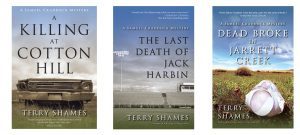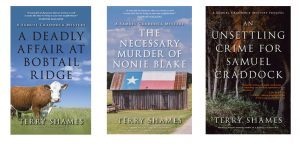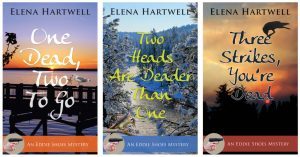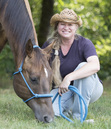Elena Hartwell's Blog, page 73
January 14, 2018
Dogs and Cats and Thriller Novels: Author Amy Shojai
This week I’m thrilled to interview author and fellow ITW member, Amy Shojai. Amy and I share a deep love for animals and adoration for International Thriller Writers!
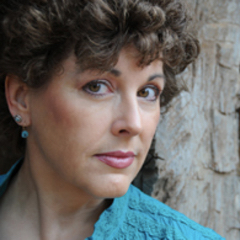 The Author
The AuthorAmy Shojai, CABC is the award winning author of more than 30 pet care books, and the September Day thriller series.
She can be found at her blog (click here), her website (click here), and connect with her on twitter (@amyshojai) and Facebook.
The Interview
As a certified animal behavior consultant you have worked extensively as an expert of cats and dogs. From animal health and behavior to challenges for pet owners, you cover it all. As an animal lover myself, what would you most like readers to know about cats and dogs and making them a part of our lives?
What a great question! And hard to offer a short answer. It’s a given that those who share their hearts (and sometimes pillows) with cats and dogs, that these creatures are sentient beings also able to choose (or not!) to share themselves with us.
They are not little humans in fur coats, as much as we like to giggle and humanize them. Cats are cats, dogs are dogs, and each communicates in unique ways, and each wants and needs very specific things to keep them happy, healthy and safe. Aside from providing shelter, food, and veterinary care, the single most important part of living with and loving a cat or dog is to learn their language, and what each wants out of life. 
Dogs want to belong to the group. Family is all important to the canine, and most could care less about being in charge. That’s pretty much true across the 400+ breeds and countless mixes. Dog society mirrors human social family groups pretty closely, so most people feel they understand dogs more readily than cats. Even so, the communication can vary between dogs and breeds, so the “grumble-play-growl” of some is not a warning, while it’s a “back off, buster!” signal from others. Body language figures prominently in doggy communication, too—a wagging tail means different things based on how high it’s held, how fast it moves, and how much fur is fluffed. And smell communication is even more important. Since people can only detect the vocal and visual signals, it’s important to learn what these mean, so you don’t “say” something to your dog that’s unintended. (Hugging is a primate signal—but for dogs, it can be a threat, and often gets children bitten!).
 Cats want to own territory. Where they live, sleep, play, and eat defines who they are and their social standing within their family. The cat on the highest perch is quite literally the “top cat” in that area. Cat society and social standing among cats is fluid, and may change from room to room, yard to yard, house to house so Top Cat in the bedroom may be different in the kitchen. Scent communication is vital (scratching, rubbing, and licking all leave scent behind), and identify both territory and friendly family groups (including kitty and doggy and human friends) with scent markings. Humans pay attention to the hisses and purrs, chirps, trills and meows (meows are usually demands aimed at people!), but body language communicates even more. For instance, cats control space simply by staring—a Top Cat can prevent other cats from using the communal litter box just by sitting near the pathway and staring.
Cats want to own territory. Where they live, sleep, play, and eat defines who they are and their social standing within their family. The cat on the highest perch is quite literally the “top cat” in that area. Cat society and social standing among cats is fluid, and may change from room to room, yard to yard, house to house so Top Cat in the bedroom may be different in the kitchen. Scent communication is vital (scratching, rubbing, and licking all leave scent behind), and identify both territory and friendly family groups (including kitty and doggy and human friends) with scent markings. Humans pay attention to the hisses and purrs, chirps, trills and meows (meows are usually demands aimed at people!), but body language communicates even more. For instance, cats control space simply by staring—a Top Cat can prevent other cats from using the communal litter box just by sitting near the pathway and staring.
Understanding and recognizing what’s normal behavior for your pet is vital. A sudden change in behavior often signals a health problem, emotional upset, or both. Folks can learn more about their pets of choice in my DOG FACTS and also my CAT FACTS books, or others.
Your love and expertise with animals plays a major role in your fiction writing. How did you come to marry the two together? How did you become a Thriller writer?
I always wanted to write fiction, but couldn’t get an agent. (Sound familiar?!) I had written extensively for the “pet press” cat and dog magazines, and a New York editor read my work and asked me to write a coffee table book about cats. Meee-WOW! Took me all of 10 seconds to say yes. Once I turned in the manuscript, she asked if I could write a dog version. THE CAT COMPANION and THE DOG COMPANION were both published by Bantam/Doubleday/Dell in hardcover in 1992, sold around 45K and 28K respectively, and then reissued in paperback for more sales. That launched my book writing career. Incidentally, these were work-for-hire projects so I got $4000 each, one-time fee, BUT it garnered attention from other publishers and got me an agent.
“I always wanted to write fiction, but couldn’t get an agent …”
My agent was fantastic. I queried her about a YA horror novel and she turned it down because “YA doesn’t sell.” My, how times change! She was interested in my nonfiction pet expertise, though, and together we went on to sell a dozen nonfiction cat and dog titles to various New York houses: Ballantine, Crown, New American Library, Rodale Press. I was so busy, there wasn’t time to pursue fiction, until eventually, the Internet competed with book sales to such an extent, we could no longer sell pet books.
I quit writing for a while, and took a “real job” teaching high school choir. During that very difficult period, I learned some hard lessons—that I’m meant to be a writer. Because I’d been “professionally published” by New York, I had a pretty low opinion of self-publishing. But I finally had time to pursue fiction, and discovered International Thriller Writers.
WOW-WOW-WOW! I attended my first Craftfest and Thrillerfest to meet and invite speakers to attend the 40th Oklahoma Writers Federation Conference—I’d been elected president. On the email list, I asked to be connected with a possible roommate, and ended up rooming with Jen Talty and Alexandra Sokolov. I made so many connections, including meeting Bob Mayer, James Rollins, Jon Land, J.T. Ellison, D.P. Lyle and so many others.
The classes gave me the kick in my ass-ets to continue writing fiction. So I went home, and re-thought even more things. When Jen Talty and Bob Mayer launched a small indie press to bring their backlist books into Ebooks, I was invited to bring my backlist pet books to their house, Who Dares Wins aka Cool Gus Publishing. That launched my new indie career, and eventually I began publishing my new nonfiction with them or on my own.
Meanwhile, I wrote the thriller I had always wanted to read. LOST AND FOUND features an animal behaviorist and the service dog she has trained for her autistic nephew. I hadn’t a clue how to write in an autistic child’s viewpoint, so when he was in the chapter, his dog Shadow became the viewpoint character. I base Shadow’s viewpoint on the way I know dogs communicate, so he doesn’t talk. His thoughts and perceptions and actions are very dog-like, rather than being that human-in-a-dog-suit stories that others may create. It tickled me, and still does. I’d entered a portion before in a contest, and was slammed and shamed for writing the dog character—the judge said “only kid’s books” did that.
The next year I entered it again into the Oklahoma Writers contest, this time winning 2nd place with some great critiques/comments from the judge—who turned out to be Jen Talty! I hired an editor, revised, and then submitted the manuscript to Jen and the book was published the fall of 2012 with Cool Gus.
I also contacted ITW and was THRILLED to be told I qualified for the Debut Author program for the 2013 conference. Oh, I also got up the nerve and emailed James Rollins and Doug Lyle to ask for possible quotes, and both gave me the best cover quotes any fiction author could wish! Since then, my next two books in the series have been graced with quotes from Jon Land and J.T. Ellison. I’ve even created a box set with the first three books.
None of this would have happened without ITW.
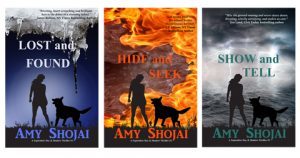
Did you grow up with animals? How did your love and appreciation for them develop?
Yes, I grew up with dogs. My grandmother lived on a farm where I got to spend time with the horses and cows, dogs and chickens. Mom used to say when I was little, I never played with dolls, only stuffed animals. She told her friends, “When Amy grows up, she won’t have babies. She’ll have puppydogs and kittycats.” Mom was right. I worked for several years as a veterinary technician, too, before attaining certification in animal behavior consulting for cats and dogs.
You’ve also worked as a playwright, performer, and composer. How do you work under so many different hats? Do you find you have to focus on one project at a time? or can you easily glide between artistic roles?
Ha! Yes, I’m easily bored. 
January 6, 2018
Terry Shames: Big Stories in Small Towns
I’m very excited about all the author interviews I have coming up in 2018. And I’m starting off the year with a bang! First up, Terry Shames, author of the award-winning Samuel Craddock series.
THE AUTHOR
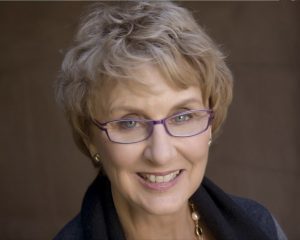
Terry Shames has been nominated for the Strand Critics award, the Macavity, and multiple Lefty awards (Left Coast Crime). She has won the Macavity Award and recently won the RT Reviews Critics Award for Best Contemporary Mystery of 2016.
She lives in Berkeley, California with her husband and two rowdy terriers.
THE INTERVIEW
You have an incredible career history, working in a variety of jobs from Yellowstone National Park to the CIA. Through it all, you’ve been a writer. What inspires you to write no matter what else is going on in your life? (with the exception of time off for parenthood?)
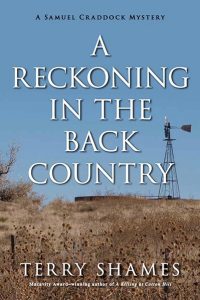 I didn’t mean to imply that I stopped writing while I was in the throes of parenting a child who “needed a lot of parenting.” I always wrote, even then. I just stopped the painful process of trying to find a publisher. So the question: what inspires me to write “no matter what?” “Inspires” is the wrong word. The right question is, what drives me to write? As a child my head was always full of stories. I loved to read and I loved to immerse myself in fantasy.
I didn’t mean to imply that I stopped writing while I was in the throes of parenting a child who “needed a lot of parenting.” I always wrote, even then. I just stopped the painful process of trying to find a publisher. So the question: what inspires me to write “no matter what?” “Inspires” is the wrong word. The right question is, what drives me to write? As a child my head was always full of stories. I loved to read and I loved to immerse myself in fantasy.
When I was very young my family lived on a small farm on the outskirts of a small town in Texas. I wasn’t around other kids much and I spent a lot of time in my head. I have no idea whether I would have had as active a fantasy life if I had lived in town and had children to play with every day. But I do know that from an early age, I always felt compelled to write.
Often, when I was working many hours a week, I’d go to my car at lunch and write. At night, no matter how tired I was, I’d scribble down an idea or a few pages of a story. I didn’t always have the stamina to complete the stories, but I realize now that what I was doing was practicing. If I had had more discipline, I might actually have become proficient earlier!
We are both fans of writing about small towns. What draws you to set your mysteries there?
I have written other mysteries that are not small town settings. But when I decided to get serious about writing—in other words, to write a book that would get published—I turned to a familiar setting. Jarrett Creek is based on the small town where my grandparents lived when I was a child—and where my mother grew up. It always held charm for me, partly because when I visited there I was always surrounded by my story-telling family. I would listen to tales told by my relatives, and the stories were always grounded in the area where they grew up. It was about setting.
However, I don’t think “big city” books are really any different. Even in cities, people tend to construct small communities for themselves. Read a book set in Los Angeles, and although the detective may roam far afield, she shops at the same grocery story, goes to the same restaurant, talks to her neighbors, and runs in the same park on a daily basis—just like a small town. I think it’s the intimacy that’s important; not the size of the city.
“Even in cities, people tend to construct small communities for themselves….”
What appealed to you about writing a series versus standalones? Will we see more Samuel Craddock novels?
I can’t remember whether I intended to write a series when I wrote A Killing at Cotton Hill. But as soon as I finished it, I immediately started The Last Death of Jack Harbin. People often remark on how fast I write, but it only seems that way because I had a head start. I had two books written before I signed a publishing contract. So while those were being published, I wrote numbers three and four.
That way, I’ve always managed to be a little ahead of the game. I am working a standalone right now, so it isn’t that I prefer a series, it’s just that once I started the Craddock books, new ones kept coming to me. After I wrote A Reckoning in the Back Country, the latest, I knew what the subject of the next book would be. After that there was a great void. I thought maybe I was done. But then I was challenged by my editor to come up with more, and three more ideas popped into my head.
As a seasoned writer with strong ties to the mystery community, what are some of the most important aspects for you of being a writer?
The most wonderful thing to me is knowing that my books are being read and appreciated. I love getting emails from readers telling me how much they love my books. I also love being part of a community of writers. Around other mystery writers, I can be myself. They understand what it’s like to face a blank page; to have the awful experience of writing yourself into a corner and not know how you will get out of it; who understand the push-pull of being an introverted extrovert or vice versa. But I think the most important aspect of being a writer is the experience of taking a raw idea and at some point realizing that I have nurtured the idea until it has become a full-blown novel. No matter how many times it happens, it seems like pure magic.
“No matter how many times it happens, it seems like pure magic.”
How has the writing process changed for you over the course of your series? Do you find you work differently now than you did when you started? What is your writing process like today?
I wish I could say I had found an easier or better process, but it’s always pretty much the same: start with an idea, keep thinking about it over a few weeks, letting the idea meander where it will, until you think it is an idea that is big enough to be a book. (Some ideas aren’t big enough. Those are the ones that melt away). Then start writing. Write some more. Keep writing. Do it again. And eventually you have a whole bunch of words. Then the real work begins of shaping those words into a coherent whole. That’s called editing: Fluff, chop, fluff, chop some more, and then do it again….and voila! You have a book. Easy, no? I don’t really have a set time to write. I find that the first draft is easier if I tackle it earlier in the day. But editing I can do anytime.
What are you working on now?
I wrote a thriller that I liked, but that needs a lot of work. I’m questioning whether it’s worth the time it will take to make it into what I want it to be. I also just finished a psychological suspense novel that I have to rethink. I suspect it would be better if it was written in first person. Plus, I wrote an adventure story that I recently revisited and I like it a lot. I realized it needs one major change that is turning out to be easier than I thought. Meanwhile, I’m working on Craddock #8. It’s cooking up nicely.
Final words of wisdom:
This fall I went to a week long writer’s retreat. There were a few beginning writers in attendance and I noticed the same thing about them that I had noticed before in workshops—that beginners seemed to worry over details that are best left for the editing phase. For example, someone might become fixated on whether a particular character should sit down before or after delivering a line; or if a description should go at the beginning of a chapter, or later in the chapter. After hearing them massage these things for a while, I finally said, “Listen, it doesn’t matter at this stage. By the time you finish the book, that paragraph might not even be relevant anymore. The important thing now is to keep going and write the damn book.’” This became a catchphrase for the retreat. When someone would start to worry over a tiny detail, someone would suddenly start grinning and we would all say together, “Write the damn book!” So that’s my advice.
“Write the damn book!”
The post Terry Shames: Big Stories in Small Towns appeared first on Elena Hartwell.
December 31, 2017
Goodbye 2017: A Writer Looks Backward and Forward at Kindness
 For a lot of us, 2017 felt like a hard year. Our world feels uncertain. Our future uneasy. Our security in question. There has been upheaval on multiple fronts. Change is never easy, either to accept or to promote. When we are in the midst of it, it can feel as if forward motion has stopped, but history shows we progress. Slowly, but surely, we progress. With a little faith, a little strength, a voice, a movement.
For a lot of us, 2017 felt like a hard year. Our world feels uncertain. Our future uneasy. Our security in question. There has been upheaval on multiple fronts. Change is never easy, either to accept or to promote. When we are in the midst of it, it can feel as if forward motion has stopped, but history shows we progress. Slowly, but surely, we progress. With a little faith, a little strength, a voice, a movement.
We lost some legends in 2017. The music world lost Tom Petty, Greg Allman, and Walter Beck. AC/DC lost Malcom Young. Rock ‘n Roll lost Fats Domino. Hollywood lost Harry Dean Stanton, Rose Marie, and Mary Tyler Moore. Robert Guillaume. Jim Nabors. Hollywood shared its loss of Sam Shepard with the theater, as an actor and a playwright who graced both screen and stage. Literature lost Gloria Naylor, Robert James Waller, and most recently Sue Grafton. 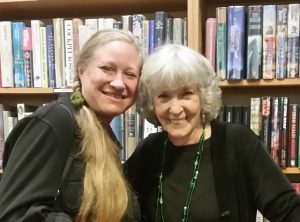
There are more, people who will never share their talent, their passion, their craft with the world ever again, except through the CDs, the films, the books they leave behind.
We can rejoice in the bodies of work they created or we can mourn their passing. We can agonize over the music and stories that will never be or we can take what they have shown us and make our own work better.
One of the complexities about our love for individuals based on their ability with a craft, is we don’t know what else they brought to the world. Did they love without reservation? Did they rescue an animal? Did they respect nature? Did they care for someone less fortunate? Can you separate the person from the art? Should you? Does it matter, after their death, what else made up their core? Were they kind?
There is little we can control in this life. We can’t force stardom or recognition or awards. We can’t determine how successful we will be. We can’t change the nature of another. We can’t cheat death. But we can choose kindness.
I have found myself, day after day, returning to the same idea. Kindness requires nothing. It does not require you to change your belief system or the party you vote for or the religion you follow. It doesn’t require that you accept people who are different or participate in something you don’t believe in. You can still be kind. All it requires is thoughtfulness for another person’s struggle. Their struggle, no matter how foreign it may be to you, is real to them.
I guess if I have one hope for the new year, it’s the same hope I have every year. That we can all take an extra second before we react and consider how our words will be heard. Take that extra moment to confirm the story we are passing on is true. That we can choose to be kind in how we approach others, no matter how they approach us.
Rise above.
As Michelle Obama said, “when they go low, we go high.”
When someone is cruel, be kind. When someone is hurtful, be kind. When someone acts out of fear, greed, anger, be kind.
Baffle the other person by rising above.
Wishing all of you health, peace, and a steadiness of heart in the coming year.
There is no us and them, that’s a lie we tell ourselves to give us distance. We may not like it, but there is only one us. And we’re all in this thing together.
Elena-

The post Goodbye 2017: A Writer Looks Backward and Forward at Kindness appeared first on Elena Hartwell.
December 23, 2017
Eddie Shoes Wishes You Happy Holidays!
Greetings everyone, Eddie Shoes here. Elena asked me to write a guest post for the holidays, so here I am. This isn’t my usual form of communication, I’ve never actually done a blog post before, but I thought it sounded like fun.
 For those of you who don’t know me, I’m a private investigator up in Bellingham, Washington. I’ve been working solo for a couple of years, ever since I moved here from Seattle. I like working solo. Well, most of the time. You see, my mother Chava showed up on my doorstep a couple years ago and she likes to butt into things, so we’ve gotten ourselves involved in a couple homicide investigations …
For those of you who don’t know me, I’m a private investigator up in Bellingham, Washington. I’ve been working solo for a couple of years, ever since I moved here from Seattle. I like working solo. Well, most of the time. You see, my mother Chava showed up on my doorstep a couple years ago and she likes to butt into things, so we’ve gotten ourselves involved in a couple homicide investigations …
Though … I guess that doesn’t really have anything to do with the holidays, so I’ll move on.
First off, let me say Happy Hanukkah for all our Jewish readers. Or, “Hanukkah Sameach” if Chava can be trusted, which she can be most of the time. She’s been researching our Jewish roots. I do like to celebrate Hanukkah. I love lighting the menorah, it looks so pretty in the window. Like a tiny light against a dark world. I’ve also become a fan of potato pancakes, Chava is a great cook, but don’t tell her I told you that.
We also celebrate Christmas. My father is Catholic, so there’s that, but Chava and I have always loved Christmas lights and Christmas trees. And presents. This year we both spent too much money on my dog Franklin. He’s closing in on one hundred-eighty pounds right now, so that’s a lot of dog to spoil. And how could you not? He has the sweetest face I’ve ever seen.
Chava has taken to throwing the odd dinner party and she thought having one for orphans at  Christmas was funny, so we had the whole gang over. Chance doesn’t have a lot of family in the area, so he showed up, neither does Iz, plus she’s my best friend so she had to come. Debbie Buse has lots of family, but she said we’re just like family, so she came over with her dogs Indy and Gracie Allen. A couple dealers from the Casino where Chava works showed up and even my father Eduardo made an appearance, though he mentioned something about travel for work and not to worry if I didn’t see him for a few weeks. I guess when you’re a hitman for the mob you have to be willing to work weekends and holidays.
Christmas was funny, so we had the whole gang over. Chance doesn’t have a lot of family in the area, so he showed up, neither does Iz, plus she’s my best friend so she had to come. Debbie Buse has lots of family, but she said we’re just like family, so she came over with her dogs Indy and Gracie Allen. A couple dealers from the Casino where Chava works showed up and even my father Eduardo made an appearance, though he mentioned something about travel for work and not to worry if I didn’t see him for a few weeks. I guess when you’re a hitman for the mob you have to be willing to work weekends and holidays.
 New Year’s Eve is going to be pretty quiet for us. I don’t really like driving around anyway and Chava has the night off, but she has to work in the morning, so it may just be the three of us hanging out watching the ball drop in Times Square.
New Year’s Eve is going to be pretty quiet for us. I don’t really like driving around anyway and Chava has the night off, but she has to work in the morning, so it may just be the three of us hanging out watching the ball drop in Times Square.
If you’d asked me a few years ago, if that’s how I’d be spending the final night of 2017, I’d have said no way. But now, I wouldn’t have it any other way.
I guess that’s all I have to say. Except, I hope everyone who reads this has a wonderful holiday and a very happy New Year. See you in 2018!
Pssst. Hey! Chava here. I know this is supposed to be my daughter’s post, but I just wanted to add a little note. I thought I’d tell you my wish for 2018. I’m wishing that all of you have someone you can depend on. Someone who will have your back, no matter if bullets are flying or dead bodies are piling up or there’s a car chase … or even just to hang out with on New Year’s Eve. I guess I’m just saying, I hope all of you have as much to be grateful for as I do, and sense enough to know it.
Love from the whole gang.
The post Eddie Shoes Wishes You Happy Holidays! appeared first on Elena Hartwell.
December 16, 2017
Demons, Debutants, and a Murdered Politician: A Recipe for Three Killer New Authors
JESSICA BAYLISS
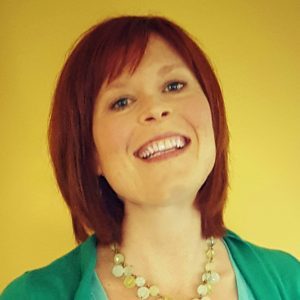 Jessica Bayliss is a fiction author with a Ph.D. in clinical psychology who loves all things reading and writing. Her work crosses genres including romance, urban fantasy, and horror. Although it’s typically advisable to focus on one audience, Jessica just can’t seem to settle down; she writes Middle Grade, Young Adult, New Adult and (eh hem) regular adult fiction.
Jessica Bayliss is a fiction author with a Ph.D. in clinical psychology who loves all things reading and writing. Her work crosses genres including romance, urban fantasy, and horror. Although it’s typically advisable to focus on one audience, Jessica just can’t seem to settle down; she writes Middle Grade, Young Adult, New Adult and (eh hem) regular adult fiction. Jessica also spends a great deal of time with friends and family. She is a lover of all animals especially one very special Havanese and one extremely ornery cockatiel. She also loves to cook, eat, and exercise (it’s all about balance, right?) and is a firm believer that coffee makes the world a better place. (I’m with you on that one Jessica!) You can also find Jessica on Twitter and Facebook. Her debut novel Broken Chords is available on Amazon, Kobo, Goodreads, and Smashwords.
THE INTERVIEW
What is one of your favorite elements in your debut novel?
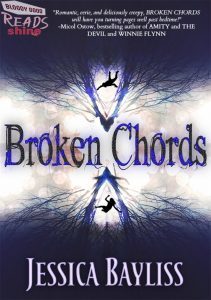
My book is called Broken Chords, and it’s a YA horror novella published by Leap Books. It’s about Lenny, a teen who tries astral projection with her friends at a music festival, and unfortunately for her, she catches the eye of a demon that is now able to tug her into its hellish realm whenever it wants. This is a fast-paced book, but it also has layers, and I love how the theme of cords/chords came together. It really just fell into place. I don’t want to give too much away—folks will have to read it to see how the click happened—but it did; it just clicked. This book was one of the most fun and satisfying to draft, actually.
What led you to writing your first novel?
My first book was sort of a random occurrence and, at the same time, a long-time coming. That sounds contradictory, but it’s true. For many writers, they’ve been writing for years. Not so much for me. I’ve dabbled a little bit here and there, but I mean it when I say just a little bit. And in 2001 I started a MG novel, which I then forgot because shortly thereafter I started graduate school. Fast forward to 2010 when I’m done with school, done with licensure (I’m a clinical psychologist), and have a real, grown-up job, and I decided I needed a hobby. I decided I’d try to write a book. I’d literally written nothing in all that time (except research papers, which is SO not the same thing). So, I started a book and it wasn’t working. Then I remembered the one I’d started all those years before. Amazingly, I had a copy of the file backed-up on my computer. I read it, cut a lot, and about a year later, that was my first book. So, both random and a long-time coming.
What are you working on now?
I’m about to dig back into revisions for another YA thriller I wrote earlier this year. I love this book. It’s a friendship story—a twisted friendship, that is—but like Broken Chords, it’s meant to be a fast-paced ride. The whole thing takes place on the NJ shore because this summer I was longing for an east coast beach vacation, and I didn’t get one. So, I wrote one for myself. That also includes a madman who sends two teenaged girls on a twisted game of dare. And their lives are at stake. (When I DO eventually get my shore vacation, I hope it won’t involve anything more threatening than sunburn and jelly fish stings.) I can’t wait to finish this one and share it.
Thanks for visiting with us, Jessica! Looking forward to reading your work.
JOHN COPENHAVER
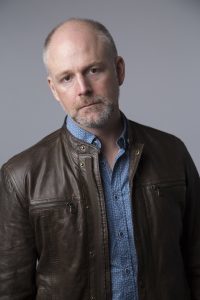 John Copenhaver grew up in southwestern Virginia and graduated with a BA from Davidson College, MA in literature from Bread Loaf School of English, and a MFA in fiction from GMU, where he served as Executive Editor of the literary magazine Phoebe.
John Copenhaver grew up in southwestern Virginia and graduated with a BA from Davidson College, MA in literature from Bread Loaf School of English, and a MFA in fiction from GMU, where he served as Executive Editor of the literary magazine Phoebe.Currently, he chairs 7-12 English Department at Flint Hill, a college preparatory school, outside of Washington, DC, where he live with his partner Jeff and two ridiculously photogenic dogs, Winky and Roxy. Dodging and Burning is his first novel. He also reviews crime fiction at Lambda Literary, you can find his column, Blacklight, here. To learn more about John, visit his website, and find him on Facebook and Twitter.
THE INTERVIEW
What is one of your favorite elements in your debut novel?
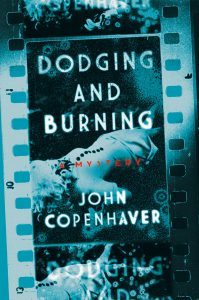 The twist in the final pages of the novel came as a surprise to me. For obvious reasons I can’t say much about it, but I will say that it was a discovery I made while writing, not something planned from the beginning. The realization was thrilling to me. That I had Bunny Prescott, my debutant-cum-novelist, make the discovery was entirely (yet unexpectedly) appropriate. She’s had to reckon with her own culpability in the past; her imagination is darker as a result. She can discern evil where Ceola can’t, whose hopefulness is a kind of blindness.
The twist in the final pages of the novel came as a surprise to me. For obvious reasons I can’t say much about it, but I will say that it was a discovery I made while writing, not something planned from the beginning. The realization was thrilling to me. That I had Bunny Prescott, my debutant-cum-novelist, make the discovery was entirely (yet unexpectedly) appropriate. She’s had to reckon with her own culpability in the past; her imagination is darker as a result. She can discern evil where Ceola can’t, whose hopefulness is a kind of blindness.What led you to writing your first novel?
Many years ago, I took a class in graduate school called “Photography and Modernity.” It was a literature course about how photography, particularly the mass reproduction of images, changed modern life and literature. We spent a lot of time discussing the power of the photographic image to communicate—and miscommunicate. At some point, I wondered what it would be like to tell a story that pivoted around an evocative crime scene image that served as the primary evidence for a murder that couldn’t be verified. With photography, the enticement is always to focus on what the photograph displays, not what is just beyond its frame. I was fascinated with the way photos gather meaning when provided with context in the form of a story. The question is: Is that story the truth?
What are you working on now?
I’m polishing up a novel manuscript set in post-WWII DC about two teenage girls, one of whom is (perhaps) a budding sociopath. They work together as amateur detectives to unwind the mysterious connection between an assault on their favorite teacher and the brutal murder of a classmate. I like to think of it as a femme fatale’s coming of age story: What were Cora Papadakis and Kathie Moffat like as young women? Can we have sympathy of the succubi?
What a great concept! Looking forward to the launch of your debut.
SARALYN RICHARD
Saralyn Richard has been a teacher who wrote on the side, but now she is a writer who teaches on the side. Some of her poems and essays have won awards and contests from the time she was in high school. Her
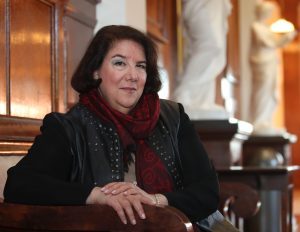
children’s picture book, Naughty Nana, has reached thousands of children in five countries.
When not writing, Saralyn likes going to movies and concerts, traveling, and walking on the beach with her husband and two dogs. She is an avid reader and is working on her second mystery, Murder at Lincoln High. Saralyn is a member of International Thriller Writers and Mystery Writers of America. For more information on Saralyn, you can visit her website, follow her on Facebook, Pinterest, Twitter, and LinkedIn
THE INTERVIEW
What is one of your favorite elements in your debut novel?
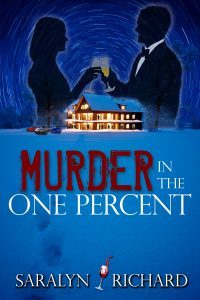
There is a certain appeal in reading a “locked room” mystery, where all of the suspects are “locked” in a particular setting at the time a murder takes place. No one has come in or gone out, and everyone has the means and motive to commit the crime. Like the detective, the reader must work out the possibilities within the narrow confines of the small setting.
In my debut mystery, Murder in the One Percent, thirteen people attend a weekend party during a snowstorm in a country mansion on a Pennsylvania horse farm. After much eating, drinking, and cigar-smoking on Saturday night, everyone retires to their rooms, and when they reconvene, one of them is found dead—on the fourth floor. The fact that all of the guests are wealthy and powerful citizens with unblemished reputations is enough to worry the detective and the police chief, but it worries the other guests, and hopefully the reader, too.
What led you to writing your first novel?
Some years ago, I attended a birthday party/weekend retreat like the one described in the book. That Saturday night I commented to another guest that this would be a great situation for a murder mystery. When I joined a writers’ critique group and considered what to write, I remembered the situation and began inventing the ensemble cast of ultra-rich characters, the connections between them, and the events that would ultimately turn their lives inside out. Once the young and unsophisticated detective made his entrance, the book took on a life of its own, as the contrasts between one-percenters and those who serve them propelled the story forward. Adding a jigger of greed, a splash of lust, and a garnish of jealousy, I felt I had the perfect story.
What are you working on now?
Currently, I am revising my second novel, Murder at Lincoln High, and contemplating a third mystery in which I bring back Detective Oliver Parrott.
Sounds like the perfect recipe for a rollicking good mystery!

Happy Reading!
The post Demons, Debutants, and a Murdered Politician: A Recipe for Three Killer New Authors appeared first on Elena Hartwell.
December 10, 2017
Writers Beware: The Perils of the Publishing Industry
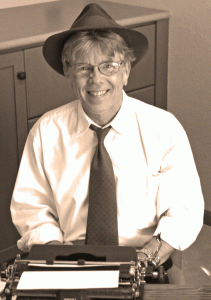 I’m very happy to host mystery author Mark S. Bacon on my blog this week. A little about Mark …
I’m very happy to host mystery author Mark S. Bacon on my blog this week. A little about Mark …
Mark S. Bacon began his career as a southern California newspaper police reporter. After working for two newspapers, he moved to advertising and marketing when he became a copywriter for Knott’s Berry Farm, the large theme park down the road from Disneyland.
Before turning to fiction, Bacon wrote business books. His articles have appeared in the Washington Post, Cleveland Plain Dealer, San Antonio Express News, and many other publications. Most recently he was a correspondent for the San Francisco Chronicle.
Take it away Mark!
The Perils Of Appropriating Pop Songs by Mark S. Bacon
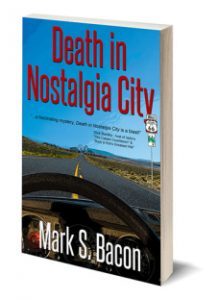 Few things are worse for a writer than the panicky feeling you get when your book is about to go to press and you realize you made a serious mistake. A costly mistake. A thousands-of-dollars mistake.
Few things are worse for a writer than the panicky feeling you get when your book is about to go to press and you realize you made a serious mistake. A costly mistake. A thousands-of-dollars mistake.
But I’m getting ahead of myself.
My first mystery novel, Death in Nostalgia City, takes place in a giant Arizona theme park. Nostalgia City is a complete re-creation of an entire small town as it would have appeared in the 1970s. Aimed at baby boomers and other seniors, the park includes period cars, clothes, food, fads, shops, restaurants, hairstyles and music. It’s the first in my mystery series.
The second book, Desert Kill Switch, was just released.
To create the impression of the past for park visitors—and readers of the mystery novels—I use references to events from the 1970s and I dress park staff in bell bottoms, white belts and other recognizable styles from forty-plus years ago. Oldsmobiles, Pontiacs and Plymouths are among the cars of the past cruising the streets of Nostalgia City.
 Because music played an important part of the 1970s, my characters listen to the Rolling Stones, Three Dog Night and other memorable groups and I mention popular songs of the period. So far, so good.
Because music played an important part of the 1970s, my characters listen to the Rolling Stones, Three Dog Night and other memorable groups and I mention popular songs of the period. So far, so good.
In my first mystery, songs are vital to the story. I use music as a murder clue. In one scene I have my two protagonists listening to Jefferson Airplanes’ “White Rabbit” and I spell out some of the lyrics. I love the song. It carries memories for those who grew up in the period.
But long after my manuscript had been submitted, edited and formatted for publication, it dawned on me that I might be getting into trouble using lyrics.
Having written several nonfiction books, I’d learned the rules for quoting material from other books. In general, the doctrine of fair use permits you to quote short passages provided they make up a tiny portion of the entire work. And you need to get written permission.
So I called my publisher. My editor told me she would contact the legal department for an opinion. But I didn’t wait. A little online research told me that when you quote lyrics you had to obtain permission from a song’s copyright holder. So who was that?
I discovered that Jefferson Airplanes’ singer Grace Slick wrote the song, but no longer controlled the rights. More research brought me to the legal department of the company that now owned those rights. I had forms to fill out, procedures to follow and the cost would be imposed on each word of the lyrics I used. Too expensive and too late.
By then I started worrying about using just song titles, let alone lyrics. Even before I heard back from my publisher, I was rewriting the chapter. I killed the lyrics and made changes just before the print book went to press and the e-book was released. I could use song titles, I was told. Whew.
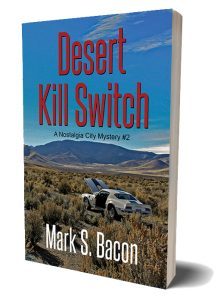 If you scan the Internet, you can find similar stories from writers who wanted to use song lyrics in their books. In an article in The Guardian, UK author Blake Morrison tells a similar story to mine, although he decided to pay for lyrics. Quoting lyrics, he reports, cost him the US equivalent of about $6,000.
If you scan the Internet, you can find similar stories from writers who wanted to use song lyrics in their books. In an article in The Guardian, UK author Blake Morrison tells a similar story to mine, although he decided to pay for lyrics. Quoting lyrics, he reports, cost him the US equivalent of about $6,000.
Authors of any artistic work, whether novels or songs, deserve to have their creative work protected, and as Morrison points out, the idea that artists have property rights is at least as old as ancient Greece. Morrison advises authors never to quote lines from pop songs.
I won’t. Even though I’d love to recall what the Lewis Carroll portal rodent spoke.
Great post Mark, so lovely to have you as my guest. I’ve always been interested in this topic, as I like to incorporate music in my theatrical work. I’ve had characters sing familiar songs onstage. As one last note, songs published before 1923 are in the public domain and can be used without copyright issue. Which works great when you’re writing a historical piece! Song titles, as you note, can’t be copyrighted, so they are usable regardless of the date of publication or release.
The post Writers Beware: The Perils of the Publishing Industry appeared first on Elena Hartwell.
December 3, 2017
Write Like a Gold Miner: Novels from Coal
As this year in writing comes to an end, I’m looking forward to having the third book in my Eddie Shoes Mystery Series launch in April. It’s hard to believe that before April 15, 2016, I wasn’t a published author and by April 1, 2018, I’ll have three books out.
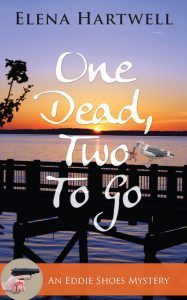
But April 15, 2016 wasn’t the start of my writing career. Not even as a novelist. My novel writing started long before I wrote One Dead, Two to Go.
Writing is a strange industry. We work alone at our computers for weeks, months, years, hoping that at some point our combination of character, plot, and word choice will lead us to a book deal. We talk about our “first books” – all the while knowing there are one or six or twelve finished manuscripts in a drawer that never saw the light of day.
Getting to that debut novel is a marathon. The writing and rewriting, the submissions, the rejections. The acceptance, then the rewriting, the launch, then the marketing. There is no road map to “author.” There is no step-by-step guide to getting to any benchmark: agent, book deal, sales, foreign rights, options.
Then comes book two. And suddenly we’re writing to a deadline. Who knew that would be so hard? 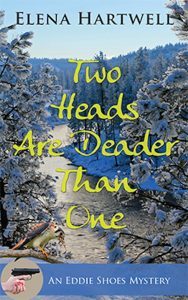
(And Two Heads are Deader Than One was much easier than Three Strikes, You’re Dead!)
Unpublished authors look at published authors with a sense of awe. The idea that their “first book” was good enough for an agent, a publisher, a “yes.” Published authors look at other published authors with a sense of awe. The multi-book contracts with big-5 publishers, the foreign translations, the movie deals. Wherever we fall on the spectrum of “author” there’s another writer ahead of us.
But we’re also a community. One of the reasons I love to go to conferences is the interactions with other writers. The conversations about edits and editors, agents and publishers, sales and marketing (so few of us do it well), the pressures of different hats, some of which don’t fit naturally. So while we may feel envy (did she really just say movie deal?) we also feel pride (she did! I’m so happy for her!). And while we may read a great novel and think, I wish I wrote this … we also have our colleagues, our peers, our idols say, “this was a great read” about one of ours.
As I work on my fourth novel – okay, yeah, it’s really my seventh – I think about everything that has gone before. Twenty years in the theater, writing and working with scripts. A Ph.D. in dramatic theory and criticism. Twenty years of teaching, helping others hone their craft. The endless pile of scripts and books to read, to read again, to pour over and analyze. The words. The words of others, the words of our own. The words, words, words, written and erased, moved around, cut and pasted into a new order only to be cut and moved and written again.
I’m not sure that I’m “better” all these years later, I just have a stronger understanding of craft. I think about early attempts, first manuscripts, first drafts, and wonder, if I knew then what I know now, would that have been my breakout play? My breakout novel? Was the diamond in the rough there, but I didn’t have the experience to find it in those unwieldy passages and unnecessary scenes and undeveloped characters? Then I think of my current writing life. Have I become too focused on output and not on art? Have I lost my voice to time constraints and other people’s ideas of what my writing should be?
Then I sit down at my computer and begin again. I write the scene. I am refreshed. By the words. The words, the words, the words.
At the heart of it all is the words. And we, like miners in a gold mine, pick our way through the tunnels. Digging into the rich vein. We succeed because we don’t give up. We walk down the path, canary in hand. And we don’t leave until the candle burns down to nothing and we have to rise to the surface.
Mine the words. Don’t be afraid of the dark. The rest will come.

The post Write Like a Gold Miner: Novels from Coal appeared first on Elena Hartwell.
November 19, 2017
Two Cozy Authors for the Price of One: Tony Perona & Liz Dombrosky = Elizabeth Perona
This week I’m joined by not one, but two amazing Cozy authors. Cozy writer, Elizabeth Perona is actually the father/daughter writing team of Tony Perona and Liz Dombrosky.
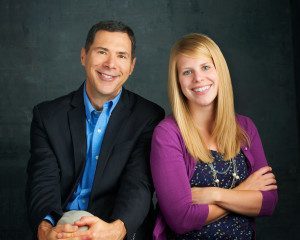
Tony is the author of the Nick Bertetto mystery series, the standalone thriller The Final Mayan Prophecy, and co-editor and contributor to the anthologies Racing Can Be Murder and Hoosier Hoops & Hijinks.
Tony is a member of Mystery Writers of America and has served the organization as a member of the Board of Directors and as Treasurer. He is also a member of Sisters-in-Crime. In his day job, Tony is currently serving as the Assistant Town Manager for the Town of Plainfield, Indiana.
Liz Dombrosky graduated from Ball State University in the Honors College with a degree in teaching. She is currently a stay-at-home mom.
Murder under the Covered Bridge
THE INTERVIEW
Tell us how the two of you decided to write mystery novels together:
LIZ: It was the editor’s idea. Dad had written the first book, and the publisher wanted to publish it. They thought it would sell better under a female name though. So, he had a couple choices. He could publish under a pen name, but it would be a little awkward to do book appearances. Or he could form a writing team with someone, and combine the names. He obviously chose the later, and I’m so glad he did!
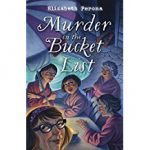
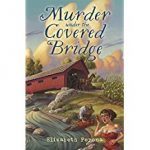
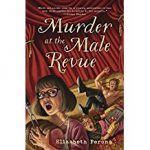
What is your process for writing together?
TONY: At the start of the novel, we discuss the basic plot outline and work through it together. Then we scout out locations together. Liz takes the lead in that. She’s really good at description: what she feels, sees, smells, hears, and thinks while she’s there. I’m terrible at the details. I’m more of the straight-ahead let’s-get-this-thing-done guy. So at that point, I’ll write the basics of the book. Then Liz will read through the manuscript, add in details like what the women are wearing, etc., edit it, and then we’ll get it to my critique group. After that, we’ll do as many drafts as necessary until it’s time to get it to our editor.
Tony, you have published novels in addition to the Elizabeth Perona books, are you planning other solo books? Liz, do you think about writing any solo books?
TONY: We’ve talked about individual efforts, but we’re pretty much dedicated to building the Elizabeth Perona brand right now.
What was the biggest surprise writing together?
TONY: For me, it was a delightful surprise that Liz was so good at the details. I hate writing details! The only ones I’m interested in are the ones that lead the detective (in our case, the ‘skinny dipping grandmas’) to the killer. So having her be in charge of that is a big relief.
LIZ: For me, I was surprised that it was fun! I know that sounds terrible, but I really just agreed to this because my dad needed help. However, it has turned out to be a fun adventure that we can have together, and I’m grateful for the opportunity!
The Bucket List Mysteries revolve around a group of septuagenarians who end up solving murders. How did you decide on that as your set of protagonists?
TONY: Since the original concept was mine and I basically wrote the first book, I’ll answer. An unnamed relative/friend told me the story of how her bridge club had had a skinny dipping party because a few of their members had never done that. It had the same setup we used in Bucket List in that it was late at night at someone’s pool when no one else was around. The story was priceless, and all I could think of was, how can I throw a dead body in here? The concept was off and running after that.
Your novels are highly praised for their humor … so … which one of you is funnier? (Just kidding). How do you weave humor into your work, are you both naturally funny, so it comes easily? Do you work at finding places to insert humor? Are your senses of humor similar? or do you find different things funny?
TONY: I think we’re both naturally funny, and we both love situational humor. Liz has the funniest Facebook posts, especially about her kids. My humor is more of taking situations and exaggerating them until almost the point of farce. You’ll find both types of humor in the novels. We do work at having at least two laugh-out-loud scenes in each book. (At least, they make us laugh out loud.)
What are you working on now?
LIZ: We’re currently working on the fourth book. We’ve spent a lot of time talking about how we can kill someone in a tattoo shop 
November 12, 2017
Historical Fiction Author Beverly Magid: Writing, Research, and John Lennon
This week my guest is historical fiction author Beverly Magid. Before writing her first novel, Beverly was a journalist and an entertainment 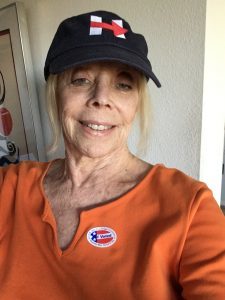 and celebrity PR executive. She interviewed many luminaries, including John Lennon, Jim Croce, and the Monty Python gang. As publicist, she represented clients in music, tv, and film, ranging from Whoopi Goldberg to John Denver and Dolly Parton to Tom Skerritt.
and celebrity PR executive. She interviewed many luminaries, including John Lennon, Jim Croce, and the Monty Python gang. As publicist, she represented clients in music, tv, and film, ranging from Whoopi Goldberg to John Denver and Dolly Parton to Tom Skerritt.
Beverly is a longtime west coast resident who still considers herself a New Yorker. She’s an advocate for social issues, including literacy, aid to victims of war atrocities, and stopping genocide. She’s also a voice for many environmental, human, and animal rights issues.
Your first two novels were also historical fiction. What draws you to write such detailed stories from the past?
There is so much to learn from past times. And sometimes it’s easier to accept the problems and their answers when we have some distance between them and ourselves. Class conflicts, anti-semitism, female empowerment, moral questions: these are not new, but seeing them through a long lens can sometime help us to better understand them in today’s world. Women have always had to be brave, but they used different methods, depending on the era.
Tell us about your research process:
Libraries, books, old newspapers, internet: I love delving into the times, the people, their clothes, what they ate, how the world looked, sounded, smelled. When you’re trying to create a full world for your characters no detail is too small or insignificant. Who knew that Hersheys Kisses were introduced in the early 1900’s? As to how the people dressed, newspaper ads and Sears Catalog were very helpful. The trick is not to get so involved with research that you never come back to writing the story.
You work as a volunteer at the Los Angeles Zoo, tell us about what you do for them and how it connects to your support of environmental issues:
After a trip to Tanzania and especially Rwanda, (before their civil war) where I trekked the 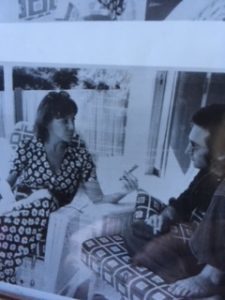 mountain gorillas, I wanted to stay connected with the animals I had just observed and become enchanted with. The Los Angeles Zoo offered a class in animal observations to better understand what motivates them and how the zoo can then make their surroundings and life more rewarding. Staying connected to the world is very important for writers, no matter what path they choose. I’ve done observations on chimps, chimp babies, mandrills, elephants, and it’s given me a deeper empathy towards other species deserving of our care and protection. Humans are the most dangerous predators and we have the biggest responsibilities towards preserving our world. (This is the first time I’ve ever had a guest on with a photo of herself interviewing John Lennon!)
mountain gorillas, I wanted to stay connected with the animals I had just observed and become enchanted with. The Los Angeles Zoo offered a class in animal observations to better understand what motivates them and how the zoo can then make their surroundings and life more rewarding. Staying connected to the world is very important for writers, no matter what path they choose. I’ve done observations on chimps, chimp babies, mandrills, elephants, and it’s given me a deeper empathy towards other species deserving of our care and protection. Humans are the most dangerous predators and we have the biggest responsibilities towards preserving our world. (This is the first time I’ve ever had a guest on with a photo of herself interviewing John Lennon!)
Where Do I Go is a continuation from Sown in Tears. How different was it to write that compared to a standalone like Flying Out of Brooklyn? Will there be a third in the series?
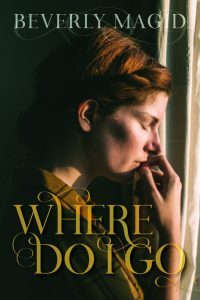 Flying Out of Brooklyn developed from a short story. I loved the characters and felt the story short-changed them and wanted to go further. Sown in Tears was inspired by an image I had after listening to a tape my father made about growing up in Russia. I could see a mother caring and worrying about her child, when he talked about my grandmother. The novel is not about her, but about that time and what would happen to a woman after an attack on her village and its aftermath. I didn’t plan on doing anything further on Leah, the heroine, but a reader asked, what happens to her after the end of the book. A simple question with a more complex answer. Thus, Where Do I Go was born.
Flying Out of Brooklyn developed from a short story. I loved the characters and felt the story short-changed them and wanted to go further. Sown in Tears was inspired by an image I had after listening to a tape my father made about growing up in Russia. I could see a mother caring and worrying about her child, when he talked about my grandmother. The novel is not about her, but about that time and what would happen to a woman after an attack on her village and its aftermath. I didn’t plan on doing anything further on Leah, the heroine, but a reader asked, what happens to her after the end of the book. A simple question with a more complex answer. Thus, Where Do I Go was born.
All three required extensive research since the times were World War 2, then Russia in 1905 and finally America in 1908. I never say never, but I’m not sure what the next project will be yet. I’m slow to make up my mind. Things have to percolate and stew a bit to mix my metaphors, before I decide what I’m writing. Since I’m also a slow writer, that means a long commitment, so I’d best be in love with the idea. And I’m not one of those writers who know the end before they start the beginning.
What have you always wanted to be asked about being a writer?
I never have any set thoughts about what a reader or interviewer will ask. The fun questions are always when someone has discovered something about the character that I didn’t even think of myself, which means that the reader has been touched by something I wrote. You never know how a story or character is going to affect a reader and it’s wonderful when it’s unexpected.
What are you working on now?
Too soon for me to have anything set in mind. I’m still working on the promotion of Where Do I Go. As political junkie, I’m also very involved with the climate of current events in our country and the world. But no matter what, books can be our solace when things get rough.
Final words of wisdom:
Write, write, write. Keep that writing muscle working and flexible. Do it for yourself, don’t censor yourself, keep connected to other arts, painting, music, dance, keep up with the world and watch and listen to everything and everybody around you. You never know where inspiration is going to come from.
The post Historical Fiction Author Beverly Magid: Writing, Research, and John Lennon appeared first on Elena Hartwell.
November 5, 2017
Clarissa Goenawan, Kathleen Valenti, and Ellison Cooper: Three Debut Novels
CLARISSA GOENAWAN
 Clarissa Goenawan is an Indonesian-born Singaporean writer. Her debut novel, Rainbirds, is the winner of the 2015 Bath Novel Award.
Clarissa Goenawan is an Indonesian-born Singaporean writer. Her debut novel, Rainbirds, is the winner of the 2015 Bath Novel Award.
Her short stories have won several awards and been published in various literary magazines and anthologies, such as The MacGuffin, Your Impossible Voice, Esquire, Monsoon Book, Writing The City, Needle in the Hay, and many others.
She loves rainy days, pretty books, and hot green tea.
To pre-purchase the book, click on the cover photo. To learn more about Clarissa, find her online by clicking on the links: Facebook
Twitter, Instagram, Goodreads
THE INTERVIEW
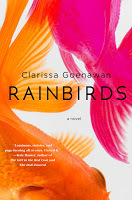 What is one of your favorite elements in your debut novel?
What is one of your favorite elements in your debut novel?When I started writing Rainbirds , I was twenty-five—just a year older than my narrator, Ren Ishida.
A lot of his struggles represent what people around my age are thinking: What kind of career should I pursue? Do I want to do this job for the next 5, 10 years? Should I settle down now? Do I really wish to spend the rest of my life with this person? And why is everyone pressuring me to do things I’m not ready for?
Being in our twenties is a very interesting phase. We’ve got tons of things to figure out. And we try our best to appear in control, even when we’re clueless and confused. But we’ll be fine. Somehow.
What led you to writing your first novel.
One day, out of the blue, this question came into my mind: “What would happen if someone I really cared about suddenly passed away, and upon their death, I realized that I didn’t know much about them?”
I then imagined a young man who lost his older brother, and later on I changed it into an older sister. I pictured a seemingly perfect woman—beautiful and elegant, kind-hearted, and with a good job—yet deep inside, she hides a dark secret.
From there, I let my characters lead me into the story, and everything grew organically.
What are you working on now:
I’m currently editing my next two novels and preparing for my 2017 NaNoWriMo project. The first and second are both literary mysteries, and the third, literary psychological suspense. Just like Rainbirds , all three are set in Japan.
KATHLEEN VALENTI
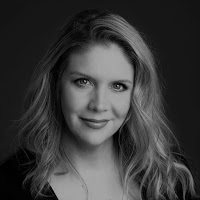 When Kathleen isn’t writing page-turning mysteries that combine humor and suspense, she works as a nationally award-winning advertising copywriter. She lives in Oregon with her family where she pretends to enjoy running.
When Kathleen isn’t writing page-turning mysteries that combine humor and suspense, she works as a nationally award-winning advertising copywriter. She lives in Oregon with her family where she pretends to enjoy running.
Protocol is her debut novel and the first of the Maggie O’Malley mystery series.
Protocol is available on Amazon, Barnes & Noble and iTunes
Learn more about Kathleen on her website, Facebook, and Twitter.
THE INTERVIEW
What is one of your favorite elements in your debut novel?
It’s tough to pick favorites when everything feels so close to your heart, but if pressed to choose just one, I’d say Charlene.
Charlene is a fairly minor character. She appears on fewer than 20 pages in vignettes that seem (at first) incidental to the main storyline. She’s critically important, however, not only in later developments, but as an emblem of the story’s overall theme. Her character—and her experience—intrigued me so much that she was originally the first voice the reader heard.
In later revisions, she moved further into the story to link milestone events, amp up the suspense and further the sense of intrigue that earlier plot points had created. She found a home as the ink that connected dots and underscored a central message.
What led you to write your first novel?
This is a frequent (and great) question, and I always seem to answer it in two parts.
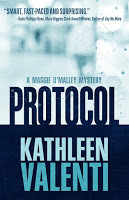 I decided to write
a
novel because after nearly 20 years of writing ad copy, I woke up one morning and wondered if I could pen anything other than a TV spot or magazine ad. It was a midlife-ish crisis that came on the heels of realizing I’d never make a “40 Under 40.” list (Because I was not, in fact, under 40 any longer.)
I decided to write
a
novel because after nearly 20 years of writing ad copy, I woke up one morning and wondered if I could pen anything other than a TV spot or magazine ad. It was a midlife-ish crisis that came on the heels of realizing I’d never make a “40 Under 40.” list (Because I was not, in fact, under 40 any longer.) As a professional writer, former literature major and avid reader, I didn’t think it would be too big of a stretch. I was dead wrong. It was by far the most challenging undertaking I’d ever attempted. I was deeply humbled by how little I knew, how many ways I would struggle, and how very kind other writers were in helping shepherd me along the way.
The reason I wrote this novel is because I wanted to write the kind of book I like to read: a tale with suspense, humor and heart. I chose to write a pharmaceutical thriller/mystery because of medicine’s ability to heal or harm and because it’s an industry rife with dramatic, villainous opportunity—i.e. ample book fodder.
The technological aspect that serves as both the inciting event and the thread that pulls the protagonist through the action was ripped from a page of my own life. Maggie O’Malley receives calendar reminders for meetings she’s never scheduled with people she’s never met. I sent my laptop in for repair and got it back with someone’s hard drive, replete with all the digital leavings you’d imagine. It gave me the kernel of a concept about technology’s ability to serve as a portal through which danger can crawl.
What are you working on now?
I’m working on the third book in the Maggie O’Malley series. The first two have tested Maggie’s mettle. In book number three, we’ll see how strong these experiences have made her.
Thanks for inviting me to participate. It’s been a pleasure! (The pleasure has been mine!)
ELLISON COOPER
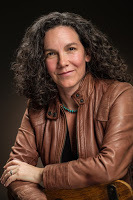 Ellison Cooper was born just outside of Washington DC where she grew up among Senators and Supreme Court Justices. She has a Ph.D. in anthropology from UCLA. She has done research in Belize, Micronesia, West Africa, and at the University of London, Institute of Historical Research.
Ellison Cooper was born just outside of Washington DC where she grew up among Senators and Supreme Court Justices. She has a Ph.D. in anthropology from UCLA. She has done research in Belize, Micronesia, West Africa, and at the University of London, Institute of Historical Research.Before graduate school, Ellison briefly attended Georgetown Law School and worked as a murder investigator for the Washington DC Public Defenders Service where she gained an insiders view of the criminal justice system. In addition, she is a Wilderness K9 Search and Rescue volunteer certified as a Federal Disaster Worker for the Incident Command System.
Caged is her first novel.
Learn more about Ellison on her website, Facebook, and Twitter
THE INTERVIEW
What is one of your favorite elements in your debut novel?
To be honest, my favorite aspect of my debut novel is...a dog. Caged is rather dark and twisty, there is a horrific serial killer on the loose, and my main character, Sayer Altair, is fierce but also fairly broken, so as I was writing I often felt the need for some relief from the darkness. That’s how Vesper came into being. He’s based very closely on my old dog Devon, the first dog I hoped to train as a Search and Rescue K9. Poor Devon turned out to be dumb as a post and just not cut out for Search and Rescue work, but he was such an endless goofball of unbridled joy he turned into one of my most beloved family pets.
What led you to writing your first novel?
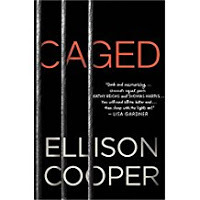
I constantly marvel at the convoluted road that led me here! Like most writers I’ve always loved writing but I never thought it could possibly become a career. Instead I went to graduate school and got my Ph.D. in anthropology. I conducted research around the world in places like Micronesia and Belize and eventually got a my dream job as professor. But, when our son was born with medical issues, I eventually had to quit my job to take care of him and I ended up spending a hell of a lot of time sitting in cars and therapist's waiting rooms. So, instead of just sitting there worrying about our son, I decided to start writing to occupy my over-busy mind.
As he got better (thank you Lords of Science and a million therapists) I decided to get a bit more serious about writing and started a novel…and got really far into it before realizing that I had a lot to learn about the craft of writing.
Since I didn’t have the time or money for writing classes, I shifted to writing short stories. I spent two years writing one to two short stories a month and I experimented wildly with genre, voice, and style so when I finally sat down to write another novel, I knew I wanted to write a crime thriller that allowed me to think about the things I love the most — cultural history, neurobiology, and dogs.
One of my favorite aspects of writing this novel was getting to incorporate so much of my academic background into the story. And that is how Caged was born.
What are you working on now?
I’ve got a three-book deal with St. Martin’s Press so I’m almost done with the next Sayer Altair book featuring a new Search and Rescue dog and a cave full of human bones. This is the first time I’ve ever written something under contract so I’m equal parts thrilled and terrified!
SaveSave

